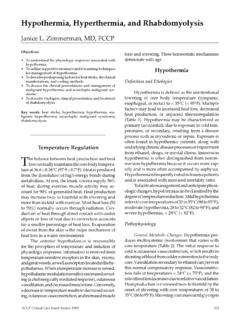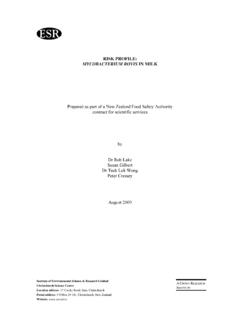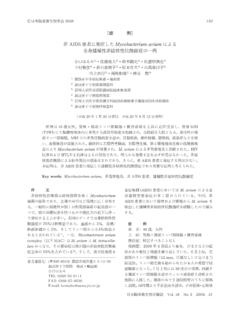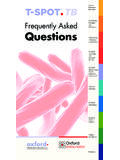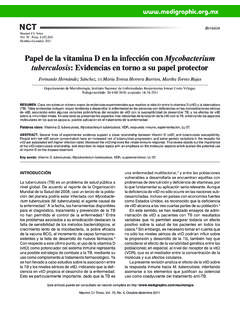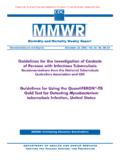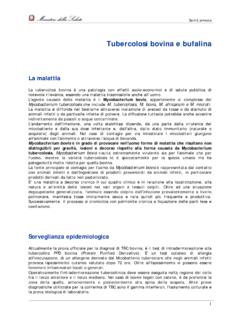Transcription of Management of disease due to Mycobacterium kansasii
1 Management of disease due toMycobacterium kansasiiDavid E. Griffith, MDDepartment of Medicine, The University of Texas Health Center, 11937 US Highway 271, Tyler, TX 75708-3154, USAIn many ways, Mycobacterium kansasiiis prob-ably the easiest of the nontuberculous mycobacterial(NTM) pathogens to treat effectively. This relativeease in treatment stems from similarities betweenM kansasiiandMycobacterium tuberculosis, espe-cially the excellent activity of antituberculosis drugsagainstM kansasii . In fact, there is more datademonstrating the efficacy of antituberculous drugsfor treatment ofM kansasiiinfections than for anyother NTM infection. Unfortunately, Management ofM kansasiiinfection involves more than just theavailability of effective drugs.
2 The similarity toM tuberculosisalso means thatM kansasiiisolatescan be associated with aggressive and destructivelung disease and that improper treatment, eithercaused by physician error or patient nonadherence,can result in extensive lung destrucion and/or theemergence of drug-resistantM kansasiiisolates. Thisdiscussion will emphasize the many weapons in thetreatment armamentarium againstM kansasiidisease,but it must be kept in mind that timely diagnosisbefore the development of extensive disease and ef-fective overall treatment strategies are equally impor-tant, ensuring that patients receive the appropriatemedications for a sufficiently long period of and epidemiologyInfection byM kansasiiprobably occurs via anaerosol route.
3 Although it is not known with certainty,tap water is likely a major reservoir forM kansasiicausing human infection. The organism has beenisolated from tap water in the same communitieswhere patients withM kansasiidisease have beenidentified [2,31]. Isolates of the same phage type asthose isolated from patients have been recovered fromdrinking water distribution systems in the Netherlands[3,4], and environmental isolates of the same geno-type, determined by pulse field electrophoresis(PFGE) as clinical isolates, have been identified inParis, France [5]. Isolation ofM kansasiifrom tapwater can be intermittent, which may explain whysome investigators have failed to recover it from thatsource.
4 No other environmental (water or soil) sourceofM kansasiihas been identified. The reasons forthis inability to isolate M kansasii from environmentalsources such as surface water are so far genetic studies have shown there is ge-netic diversity amongM kansasiiisolates recoveredthroughout the world [5,6]. A frequently used tech-nique is Restriction Fragment Length Polymorphism(RFLP) analysis of chromosomal DNA. The proced-ure entails Endonuclease digestion of whole DNAwhich yields many variably sized fragments that areseparated by Pulsed Field Gel Electrophoresis (PFGE).The DNA fragment patterns may be read and com-pared visually or scanned into a computer base.
5 Onerecent DNA-based study using PFGE has shown thepresence of five taxonomic groups among both envir-onmental and human isolates [5]. One predominantPFGE pattern, however, was found in patients withM kansasiidisease [5]. Zhang el al recently evaluated51 clinical isolates ofM kansasiifrom the UnitedStates by PFGE [6]. Half of the United States isolateshad the same PFGE pattern that was the predominantpattern reported by Picardeau [5]. Epidemiologic stud-ies of strain relatedness ofM kansasiiin suspectedoutbreaks will be difficult, given the close relationshipof most clinicalM kansasiiisolates by disease caused byM kansasiioccurs in geo-graphic clusters. In studies from southeast England0272-5231/02/$ see front matterD2002, Elsevier Science (USA).
6 All rights : S0272-5231(02)00016-3E-mail Griffith).Clin Chest Med 23 (2002) 613 621andinWales,M kansasiidisease occurred morefrequently than disease caused byMycobacteriumaviumcomplex (MAC) [7,8]. Because it is not a publichealth problem and not reportable, only estimates areavailable for its relative kansasiiisgenerally the second most common cause of NTMlung disease in the United States and occurs mostcommonly in the southern and central United States ina pattern described as an inverted T . The states withthe highest incidence of disease include the southernstates of Texas, Louisiana, and Florida, and the centralstates of Illinois, Kansas, and Nebraska.
7 Bittner et alrecently reported thatM kansasiiwas the most com-mon mycobacterial pathogen isolated at a VeteransAffairs Hospital in Omaha, Nebraska, over a 20-yearperiod between 1971 and 1990 [9]. In this study, thenumber ofM tuberculosisisolates declined over a20-year period, whereas the number ofM kansasiiisolates remained relatively stable over that same timeperiod and resulted in a total number ofM kansasiiisolates that exceeded the number ofM tuberculosisisolates. In a demographic study of NTM pulmonarydisease in Texas,Mkansasii was second only to MACas a cause of NTM lung disease . It was also reportedthatM kansasiicases were significantly more likely tocome from urban than rural areas, which is consistentwith our current understanding of reservoirs ofM kansasii , as noted above [10].
8 In geographic areaswhere HIV infection is common, the prevalence ofM kansiasiidisease may be very high. This increase islikely explained by the susceptibility of the hostpopulation at risk forM kansasiiinfection rather thanfactors related to presence of the organisms in theenvironment or virulence of the organisms [11].Clinical aspects ofM kansasiidiseasePulmonary disease is the most frequent clinicalmanifestation ofMkansasiiinfection in immuno-competent patients. Of all NTM,M kansasiilungdisease most closely parallels the clinical course ofM kansasiiprimarily affects middle-aged white men, but it can affect adult patients of anysex, race, or age. Risk factors forM kansasiiinfectioninclude pneumoconiosis, chronic obstructive lung dis-ease (COPD), previous mycobacterial disease , malig-nancy, and alcoholism [1,10 14].
9 The combination ofHIV infection and silicosis can result in potent sus-ceptibiltiy to mycobacteria includingM kansasii [12].A recent study also found that approximately 40% ofimmunocompetent patients withM kansasiilung dis-ease had no identifiable predisposing condition [11].Until recently, symptoms ofM kansasiilungdisease were felt to be essentially identical to thoseof patients with reactivation pulmonary chest radiographic changes were also describedas very similar to reactivation pulmonary tuberculosisincluding cavitary infiltrates with an upper lobepredilection (Fig. 1). In some series, approximately90% of patients with disease caused byM kansasiihad cavitary infiltrates [10].
10 Not surprisingly, manypatients withM kansasiilung disease enter the healthcare system as tuberculosis suspects. Noncavitary ornodular/bronchiectatic lung disease has been recog-nized as a major feature of disease caused by MACandM abscessusbut has not been recognized as partof the spectrum ofM kansasiilung is nowapparent, and perhaps not surprising, that patientswithM kansasiilung disease can also present withnoncavitary (nodular/bronchiectatic) infiltrates sim-ilar to MAC lung disease [15] (Fig. 2). Thoughnodular/bronchiectatic disease accounts for 50% ofMAC lung disease , it is unknown how often this formofM kansasiilung disease occurs. The natural historyof cavitary lung disease caused byM kansasiiinFig.
